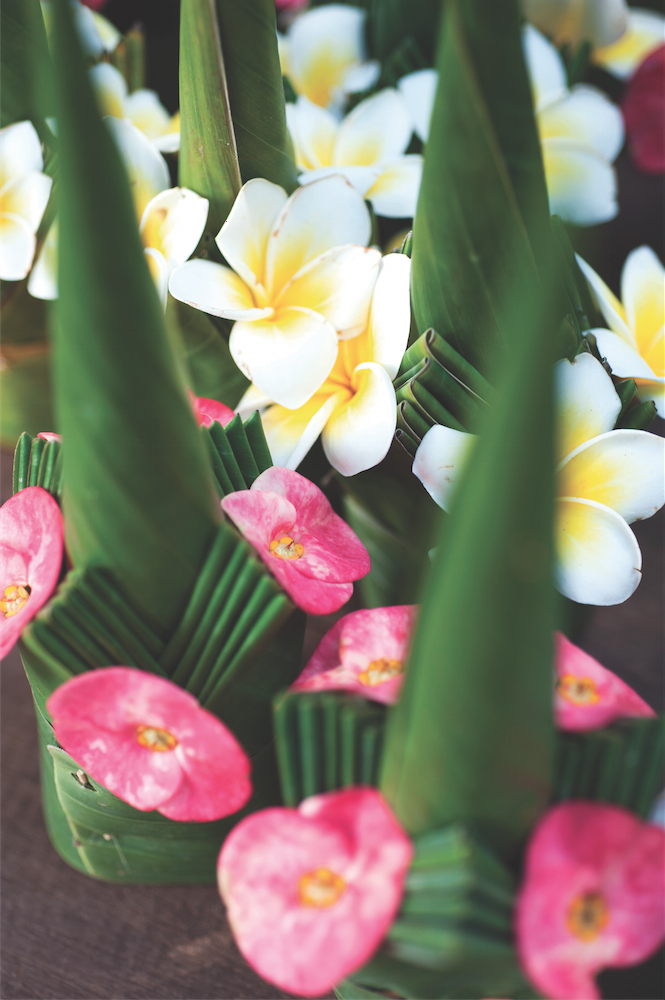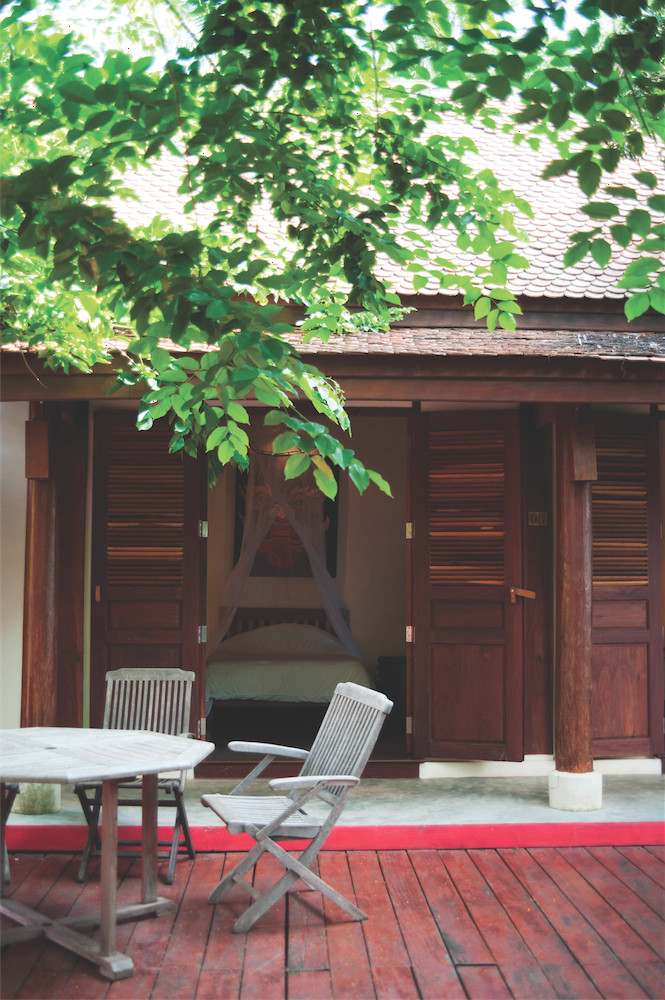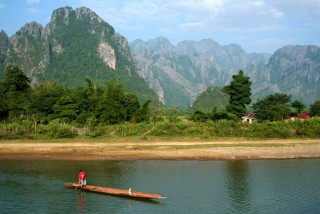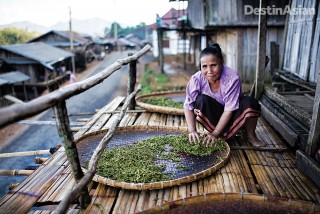Above: A suspension bridge in the Dong Hua Sao National Protected Area.
Slowly opening to mainstream tourism, Laos’s southernmost province offers attractions aplenty for travelers willing to stray off the beaten track
Story and photography by Leisa Tyler
Long after the waters of the Mekong River flow from their source in the frozen tundra of China’s Qinghai Province, tumble off the Tibetan Plateau, and slide past the ancient kingdoms of Lanna and Luang Prabang, they arrive in Champasak province, in the southernmost reaches of Laos. Here, surrounded by towering peaks thick with rain forest and coffee plantations, the Mekong widens to 14 kilometers and splits into countless tributaries as it passes through Si Phan Don, an archipelago of thousands of islands and sandbars. Flanked by grassy mounds sprinkled with lanky coconut palms, stilted fishing villages, ancient ruins, and the golden spires of Buddhist temples, the river is serene and idyllic.
Despite its myriad attractions, Champasak’s relative isolation has kept it off the beaten track. The province is closer to Phnom Penh than Vientiane, and until recently, getting here required several plane changes or a lengthy overland journey. Backpackers have been trickling in for years, thanks to cheap accommodation and the sleepy pace of life. But now, Champasak seems on the verge of attracting wider attention.
“We’re starting to see interest in the area,” says Jay Tindall, cofounder of Remote Lands, an American company offering upmarket bespoke tours in Asia. “There are a lot of really exotic–and still totally undiscovered–places here.”
Champasak’s most important historical site is Vat Phou. A temple complex of Angkor-era ruins, this was a major pilgrimage site during the Khmer Empire, which ruled over southern Laos from the 10th to 13th centuries. Consisting of a tiny prayer hall at the top of a tall stone stairway, and two reception halls on the plains below, Vat Phou admittedly lacks the magnificence of the temples across the border in Cambodia. But its layout is deeply symbolic. Tucked under the phallic peak of Phu Kao–thought to represent Mount Meru, the sacred mountain at the center of the Hindu cosmology–the terraced complex was worshiped as the embodiment of Shiva, while its sacred spring was associated with Shiva’s wife, the goddess Parvati.

Offerings at Vat Phou.
“Vat Phou could quite well have been the first–the preeminent–Angkor temple,” says Daniel Davenport, an Australian archeologist and author of a forthcoming guide to the monument. Davenport is taking me on a tour around Champasak town, the small riverside community that serves as the gateway to Vat Phou. After visiting the temple, we trek across rice fields and into the jungle to see the remains of an ancient wall that once ringed Shrestrapura, a bygone city dating to the fifth century.
At a glance, Champasak doesn’t seem to have changed much since my first visit in 1999, when visitors stayed in rickety bamboo bungalows and getting to Pakse, the provincial capital, required crossing the river by ferry. The sleepy streets are still lined with shophouses and gently decaying colonial piles, but now there are two pleasant boutique hotels, a quaint spa, and a new road offering a straight run into Pakse.
Centered on a creamy-white colonial mansion, the Inthira Hotel Champanakone has 14 rooms clustered around a wood-decked courtyard and a café overlooking Champasak’s main street. From here, it’s a short walk to another welcome addition, Frice & Lujanie, an unassuming restaurant that cooks up 18th-and 19th-century recipes from northeast Italy’s Friuli region. Everything, from the pasta to the porchetta, is homemade; best of all, you can stuff yourself silly for pennies. My bill for two people, including several glasses of wine, comes to less than US$25.
For those looking for an even quieter roost, there’s La Folie Lodge, a French-run property that opened a few years back on Dong Daeng Island, a slither of land on the opposite side of the Mekong. Here, 24 semi-detached rooms and a big swimming pool are surrounded by manicured gardens.
From Champasak town, you can take a longtail boat south to Si Phan Don (“Four Thousand Islands”) and the Khone Falls, a series of cataracts that prevent boats from passing between Cambodia and Laos. The rapids, which span almost 10 kilometers, frustrated French colonialists’ attempts to use the river as a highway for trade. A small museum on Khone Island commemorates French efforts to surmount this obstacle, its star attraction the locomotive of a long-defunct, small-gauge railroad built to portage goods across the rapids.

A Lao-style guest room at Inthira Hotel Champanakone.
You can spend a pleasant enough night at the Sala Don Khone, a small hotel with tidy floating bungalows and guest rooms in a colonial-era house. But the area is best visited as part of a three-day excursion aboard the Vat Phou, an old lumber barge that has been converted into a 12-cabin floating hotel by Mekong Cruises. The lovely teakwood ship cruises through Si Phan Don, taking in the head of the rapids and the obscure Khmer ruins of Oum Moung. The staff on board speak very little English, but the vessel’s two open-air decks–both fitted with plush lounges and rattan planter’s chairs–are the perfect place to take in the river life, preferably with a Beer Lao in hand.
A more energetic way to explore Champasak is with an adventure outfit called Green Discovery, whose Tree Top Explorer offers a vertiginous and sometimes terrifying trekking route through the Dong Hua Sao National Protected Area. Established in January of this year, it’s also southern Laos’s first real ecotourism venture.
The trail passes through farmland and coffee plantations before reaching the first of a series of steel zip lines suspended across a deep gorge. Zip-lining is not for the faint-hearted; my first jump is made especially frightening by a wall of thick mist. Casting off feels like jumping into a void.
Gathering my wits, I sail back and forth across the gorge, using a forked wooden stick as a brake and gaining confidence with each jump. Eight exhilarating but exhausting zip lines later, we stumble into the Jungle Hotel Paksong, a village-like cluster of tree-house guest rooms, bathroom facilities, and a cafeteria offering jaw-dropping views over the Dong Hua Sao waterfall. Inthy Deuansavan, Green Discovery’s Laotian owner, tells me he spent several years lobbying the government for rights to establish ecotourism ventures in the gorge and save it from the clutches of a company intent on building a hydroelectric plant here.
Deuansavan and his team carried in a small portable sawmill to construct the hotel, plus a small turbine to provide 24-hour electricity for lights, a hot-water system, and a small fridge (although during my visit, the hot water and most of the lights were not working). Despite these amenities, accommodations are basic; the facility can only be reached via zip line or by a hands-and-knees climb straight up the mountain, limiting provisions and access to clean linen.
Yet worn out by my four-hour journey, I’m immune to any discomfort. That night I fall into a deep sleep. I wake the next morning to the sounds of the jungle: monkeys hollering, frogs croaking, and the call of a rare blue pitta bird as it skirts through the canopy. A blanket of mist is slowly climbing up the valley. Then the sun appears, streaming through gangly branches, glistening off the leaves and creating a medley of green. Like Champasak province, the Jungle Hotel may be difficult to get to, but moments like these make it worthwhile.
THE DETAILS:
CHAMPASAK
Getting There
National Carrier Lao Airlines (laoairlines.com) flies daily between Vientiane and Pakse, from where it is an hour’s drive to Champasak town. The airline also connects Pakse with Siem Reap, Ho Chi Minh City, and Bangkok via Savannakhet, albeit less regularly.
Where to Stay
** Paksé Hotel: Sixty-three tidy rooms and a rooftop restaurant in downtown Pakse. St. 5, Bane Watlouang; 856-31/ 212-13; hotelpakse.com; doubles from US$35.
** Inthira Hotel: Ban Vat Amard, Champasak; 856-31/214-059; inthirahotels.com;
doubles from US$40.
** La Folie Lodge: Done Daeng Island, Champasak; 856-30/ 534-7603; lafolie-laos.com; doubles from US$95
What to Do
** Mekong Cruises: Three-day cruises from Champasak town to Si Phan Don and back again on a reconditioned teak barge. 856-21/215-958; mekong-cruises.com; from US$158 per person.
** Tree Top Discovery: Zip-line course in the forests of Dong Hua Sao. 856-21/264-528; greendiscoverylaos.com.
Originally appeared in the August/September 2011 print issue of DestinAsian magazine (“Changing Champasak”)






